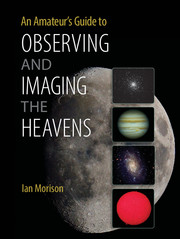Book contents
- Frontmatter
- Dedication
- Contents
- Preface
- Acknowledgements
- Prologue A Tale of Two Scopes
- 1 Telescope and Observing Fundamentals
- 2 Refractors
- 3 Binoculars and Spotting Scopes
- 4 The Newtonian Telescope and Its Derivatives
- 5 The Cassegrain Telescope and Its Derivatives
- 6 Telescope Maintenance, Collimation and Star Testing
- 7 Telescope Accessories
- 8 Telescope Mounts
- 9 The Art of Visual Observing
- 10 Visual Observations of the Moon and Planets
- 11 Imaging the Moon and Planets
- 12 Observing and Imaging the Sun
- 13 Observing and Imaging with an Astro-Video Camera
- 14 DSLR Deep-Sky Imaging
- 15 Imaging with Cooled CCD Cameras
- 16 Auto-Guiding and Drift Scan Alignment
- 17 Spectral Studies
- 18 Improving and Enhancing Images in Photoshop
- Index
- Plate Section
4 - The Newtonian Telescope and Its Derivatives
Published online by Cambridge University Press: 05 June 2014
- Frontmatter
- Dedication
- Contents
- Preface
- Acknowledgements
- Prologue A Tale of Two Scopes
- 1 Telescope and Observing Fundamentals
- 2 Refractors
- 3 Binoculars and Spotting Scopes
- 4 The Newtonian Telescope and Its Derivatives
- 5 The Cassegrain Telescope and Its Derivatives
- 6 Telescope Maintenance, Collimation and Star Testing
- 7 Telescope Accessories
- 8 Telescope Mounts
- 9 The Art of Visual Observing
- 10 Visual Observations of the Moon and Planets
- 11 Imaging the Moon and Planets
- 12 Observing and Imaging the Sun
- 13 Observing and Imaging with an Astro-Video Camera
- 14 DSLR Deep-Sky Imaging
- 15 Imaging with Cooled CCD Cameras
- 16 Auto-Guiding and Drift Scan Alignment
- 17 Spectral Studies
- 18 Improving and Enhancing Images in Photoshop
- Index
- Plate Section
Summary
As its name implies, the Newtonian telescope was invented by Sir Isaac Newton in 1668. Newton suspected that white light was made up of a spectrum of colours and that the chromatic aberration seen in the singlet objectives used in refracting telescopes was due to the light being split into its constituent colours. He thus reasoned that if an image were made using a concave mirror, chromatic aberration would not occur. He chose to make a spherical mirror out of speculum metal, an alloy of tin and copper, and used a flat elliptical mirror to reflect the converging light path sideways to the eyepiece situated just outside the telescope tube – this being the hallmark of the Newtonian design. The theoretical surface of the concave mirror is parabolic. Usually the mirror blank is first made to have a spherical surface, which is then figured to a parabolic shape. Below about 100 mm in aperture, the difference in the two is sufficiently small for this second step not to be required.
Using a mirror of 33-mm aperture, Newton was able to see the moons of Jupiter and the crescent phases of Venus, but otherwise it is not thought that he carried out any astronomical observations. Over the years the quality of reflecting telescopes improved, reaching a first high point when, in 1781, an amateur astronomer, William Herschel, used a 160-mm, f13 telescope to discover the planet Uranus. His mirror was figured more accurately than those used by professional astronomers of the time, and so his images were clearer, enabling him to see that what had been thought by other observers to be a star had, in fact, a planetary disk.
- Type
- Chapter
- Information
- An Amateur's Guide to Observing and Imaging the Heavens , pp. 57 - 73Publisher: Cambridge University PressPrint publication year: 2014



